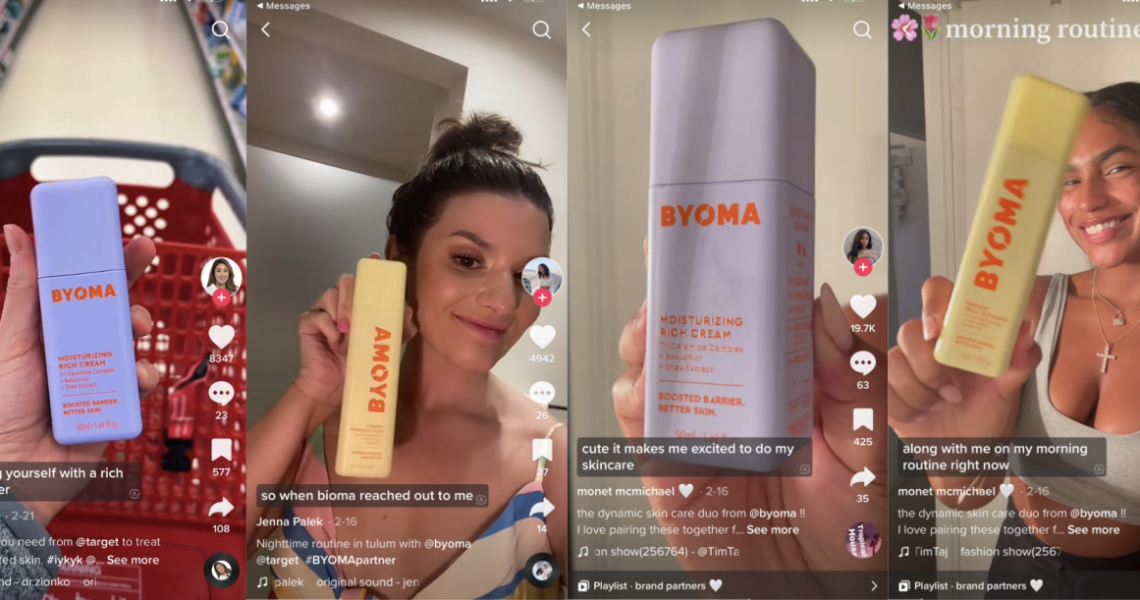In February, Future Beauty Labs launched skin-care brand Byoma. It’s currently comprised of seven products, all of which are sold at Target and range in price from $12-$16. All of Byoma’s products speak to one of skin care, and skin-care TikTok’s, most popular topics of late — the health of the skin barrier.
“We had this ‘aha’ moment,” said Noelle Cantanaro, vp of global marketing at Future Beauty Labs, speaking about the impetus for Byoma. “People are buying more skin care, they’re using more skin care, there’s more education, they’re turning to TikTok, they’re listening to derms. … But their skin is not getting better, it’s getting worse.”
To address the problem, the Future Beauty Labs team chose to focus its next brand on the skin barrier. “A lot of consumers were associating the signs of a broken skin barrier with the need to exfoliate more, when in fact, they [should have just] taken a step back and focused on barrier health,” said Marc Elrick, CEO and founder of Future Beauty Labs. He explained that educating people about the skin barrier was the main goal of the brand’s debut campaign.
Seven-year-old Future Beauty Labs is already home to a roster of popular sunless tanning brands including Tan Luxe and Isle of Paradise. When it launched Byoma, its first true skin-care brand, it aimed to make a splash on TikTok, relying on a three-pronged approach to select paid talent. Hundreds of additional creators were gifted Byoma products.
“The first category encompassed the designated ‘noisemakers.’ Those are people who have big audiences and [who are] super engaged. They’re trendsetters; when they talk about something, their followers run out and buy it,” Cantanaro said. These included creators outside of those only focused on beauty, such as lifestyle creator Jenna Palek, who has over 547,000 followers. Then, the company tapped dermatologists, including Dr. Zion Ko (524,000 followers), to speak more specifically to the science behind the brand. “They would talk about the skin barrier, the science and the ingredients,” Cantanaro said. Finally, Byoma employed “skinfluencers,” who filled the role of “people you would typically turn to for skin-care advice, or for what’s new, hot and trending [in skin care], [as well as] why and what they should buy.” In total, 28 paid creators, with followings from micro to macro, were tapped for the campaign, creating 82 pieces of content, all of which used the hashtag #ByomaPartner.
“They all spoke about the same thing, essentially. It was just delivered and executed in a very different way,” said Elrick. Key to the campaign’s success was allowing the creators to be themselves, rather than dictating a script. According to Elrick, this approach only works when a brand’s “created something that actually performs.”
No longer will a campaign work if it’s simply built on “packaging and marketing,” he said.
Ad position: web_incontent_pos1
TikTok released a business case study on the performance of the campaign, which speaks to the platform’s role in getting Byoma off the ground. From its February launch until May, Byoma gained over 137,000 followers on TikTok and its products sold out at Target stores across the country. As of the publishing date of this story, the brand’s TikTok account had 181,000 followers. Byoma’s repurchase rate is 28.3%, double the category average, and it has sold over $500,000 worth of its Moisturizing Gel Cream alone. TikTok’s report noted that Byoma’s campaign drove over 500,000 clicks to Target.com, “allowing Byoma to surpass sales projections.”




